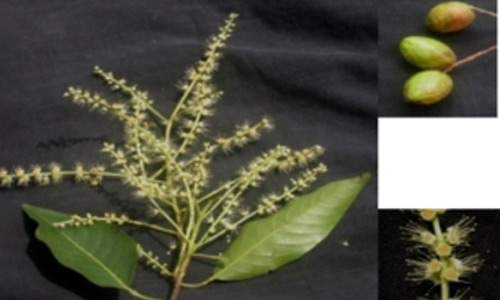|
Division
|
Angiosperms |
|
Class
|
Dicotledons |
|
Subclass |
Polypetalae |
|
Series |
Calyciflorae |
|
Order |
Myrtales |
|
Family
|
Combretaceae |
|
Genus
|
Terminalia |
|
Species
|
chebula |

|
Botanical name:
|
Terminalia chebula Retz. |
|
Local/Trade Names: |
Chebulic Myrobalan, Harad, Harra. |
|
Conservation status: |
Occur wild also cultivated for fruits. |
|
Digonestic features: |
Fruit 5 ribbed. |
|
Description: |
A deciduous tree. Bark grey to blackish, rough, with shallow vertical furrows. Leaves 7-18 x 5-10 cm, elliptic or ovate-oblong, petiole usually with two or more glands near the top. Flowers dull white, ca 1.5 cm across. Fruit a drupe, 2.5-3.5 cm long, obovoid or ellipsoid, more or less 5-ribbed; stone bony, obscurely angled, rough with gum vessels on the walls. |
|
Phenology: |
Fls.: Hot season. Frts.: Jan.-Mar. Leafless: Feb.-Mar. |
|
Distribution: |
Abundant in Northern India from Uttarakhand to Bengal and southwards to the Deccan. Sri Lanka, Myanmar and Malaya. |
|
Where to see it: |
Gate No. 2 side and Flowering Tree Section. |
|
Uses: |
Dried flesh of the fruit, surrounding the kernel, is rich in tannin (30-32%) and is an important tanning material. Roots, bark and wood also contain tannin. Fruits laxative, stomachic, tonic, and alternative; form a constituent of triphala, an important Ayurvedic medicine used for a host of ailments. Laxative principle, a glycoside, may be similar to sennoside. Fruit pulp is used in dentifrices. Coarsely powdered fruit is smoked in asthma. Bark diuretic and cardiotonic. Kernels yield a fatty oil. Tree yields a gum. |
Chief Conservator of Forests & Chief Wildlife Warden is the Head of the Department. There is one post of Conservator of Forests & two posts of Deputy Conservator of Forests viz.